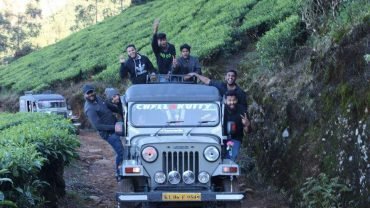Nestled in the verdant Western Ghats of Karnataka, the Bandaje Trek offers an exhilarating adventure for mountain climbers seeking a blend of challenging terrain and breathtaking natural beauty. This guide aims to provide everything you need to know to conquer this Bandaje trek, from preparation tips to trail highlights and safety measures.
Introduction to Bandaje Trek
The Bandaje Trek is located in the Charmadi Ghats region of Karnataka, known for its dense forests, cascading waterfalls, and panoramic views of the Western Ghats. Spanning approximately 15-18 kilometers round-trip, this trek is classified as moderate to difficult, making it suitable for climbers with varying levels of experience. The journey typically takes 2-3 days to complete, allowing trekkers to immerse themselves fully in the stunning landscapes and diverse ecosystems along the trail.
Best Time to Visit to Bandaje Trek
The ideal time to embark on the Bandaje Trek is during the post-monsoon season, from September to February. During this period, the weather is pleasant with clear skies, offering optimal conditions for trekking and unhindered views of the surrounding valleys and peaks. It’s advisable to avoid the monsoon season (June to August) due to heavy rainfall, which can lead to slippery trails and increased risks.
Trail Highlights and Challenges
The Bandaje Trek is renowned for its scenic vistas and unique challenges that test the endurance and skills of mountain climbers:
- Scenic Landscapes: Experience panoramic views of lush green valleys, tea estates, and distant mountain ranges of the Western Ghats. The trail offers numerous vantage points where trekkers can pause to admire the natural beauty and capture memorable photographs.
- Waterfalls: Encounter several picturesque waterfalls along the route, including the stunning Bandaje Arbi Falls. These cascades provide refreshing spots to rest, rejuvenate, and enjoy the sights and sounds of cascading water amidst the tranquility of the forest.
- Flora and Fauna: Traverse through diverse ecosystems ranging from tropical rainforests to grassy meadows dotted with wildflowers. The region is home to a variety of flora and fauna, including endemic species of birds and butterflies, offering opportunities for nature enthusiasts and photographers alike.
- Challenges: The Bandaje Trek presents various challenges such as steep ascents, narrow ridges, and rocky paths. Trekkers must be physically fit and mentally prepared to navigate these terrains, using trekking poles for stability and maintaining a steady pace to conserve energy.
Essential Gear and Preparation for Bandaje Trek
To ensure a safe and enjoyable trekking experience on the Bandaje Trail, it’s essential to pack the following gear and undertake necessary preparations:
- Trekking Gear: Wear sturdy hiking boots with good ankle support, lightweight and moisture-wicking clothing suitable for varying temperatures, a waterproof backpack with essentials (water bottle, snacks, first aid kit, headlamp/flashlight, navigation tools), and trekking poles for stability on uneven terrain.
- Fitness Level: Engage in regular cardiovascular exercises and endurance training to build stamina and prepare for long hours of trekking. Practice hiking on inclines to simulate trail conditions and enhance your physical readiness.
- Permits and Permissions: Obtain necessary permits or permissions from local authorities or trekking organizations before embarking on the trek. This ensures compliance with regulations and facilitates access to restricted areas along the trail.
Camping and Accommodation
Camping is a popular choice for overnight stays during the Bandaje Trek, allowing trekkers to immerse themselves in the tranquility of nature and enjoy starlit skies away from urban noise. Plan your camping spots in advance, choosing safe and designated areas that adhere to environmental guidelines. Alternatively, nearby villages offer homestay accommodations, providing opportunities to experience local hospitality and cuisine while supporting the community.
Safety Tips
Safety should always be a top priority when trekking in remote and challenging terrains. Follow these safety tips to minimize risks and ensure a memorable and incident-free adventure:
- Weather Awareness: Monitor weather forecasts before and during the trek. Be prepared for sudden changes in weather conditions, including rain showers or temperature fluctuations, by carrying appropriate rain gear, extra layers of clothing, and waterproof coverings for your gear.
- Hydration and Nutrition: Stay hydrated throughout the trek by drinking water regularly and carrying an adequate supply of fluids. Pack nutritious snacks and energy-boosting foods such as nuts, dried fruits, and protein bars to maintain energy levels during prolonged hikes.
- Group Dynamics: Trek in groups or with experienced guides familiar with the Bandaje Trail. Maintain communication with fellow trekkers, adhere to designated meeting points, and assist each other as needed to ensure everyone’s safety and well-being.
- Environmental Responsibility: Practice Leave No Trace principles by disposing of waste properly, minimizing your ecological footprint, and respecting local flora, fauna, and cultural heritage. Leave the trail cleaner than you found it to preserve its natural beauty for future generations of trekkers to enjoy.
Conclusion
Embarking on the Bandaje Trek offers more than just a physical challenge—it’s an opportunity to connect with nature, discover hidden gems of the Western Ghats, and create lasting memories amidst breathtaking landscapes. By preparing meticulously, respecting the environment, and embracing the spirit of adventure, you can embark on a transformative journey that celebrates the beauty and diversity of Karnataka’s wilderness.
Are you ready to conquer the Bandaje Trek? Gather your gear, plan your itinerary, and embark on an unforgettable expedition into the heart of nature’s playground. Adventure awaits—let the Bandaje Trek be your next mountain climbing triumph!




Comment (0)